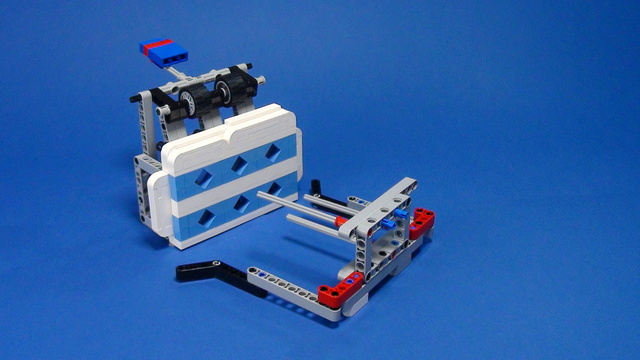In part one we build an attachment that uses a rubber band to solve a competition challenge. The rubber band was released with the use of a motor. In this video we are removing the dependency on the motor and you could use the motor for other missions.
- #93
- 21 Jun 2015
- 4:02
- LEGO MINDSTORMS, LEGO MINDSTORMS EV3
- FIRST LEGO League, FIRST LEGO League 2014-2015 World Class, Attachments, Rubber band, FLL 2014, EV3, FLL, Construction
Ideally one could solve all the competition challenges from every FIRST LEGO League competition with only one attachment. I have personally seen this at a competition in Manheim, Germany a few years ago. Well, actually, not all the mission models were solved because there was not enough time, but if they had more time - they could solve the whole competition with only one attachment.
This is where the rubber bands come to play. For most attachments you need a motor and you can only use a limited number of motors at each competition round. So an attachment triggered with a rubber band could solve a model without the use of a motor. And you could use unlimited number of rubber bands for a robot construction and there are few in each EV3 and NXT Mindstorms set.
Rubber band attachment without motor
EV3 Competition Robot Full
Building instructions for a Full LEGO Mindstorms EV3 Competition Robot that could be used in LEGO Robotics competitions.
English
- In a previous episode, we built an attachment that uses a rubber band. It solves a 2014 mission by triggering the attachment and releasing the rubber band, but this attachment was dependent on the robot motor. In this video, we are going to improve the attachment so that it does not depend on the motor. First, we start with the attachment from the previous video. It contains a rubber band right here, and this rubber band was dependent on the motor. The motor actually released the rubber band and then fired the mission element. In this video, we remove the dependency on the motor and we can have the motor free for other missions. First, I will add this axle here and we will have it hold the rubber band.
Now the attachment is loaded. I'm going to bring it closer to the camera. You can see the rubber band, it holds on this axle. When we remove this axle, it will release the rubber band and fire at the element. Now the question is how to do this without the motor. We want to do this on pure movement. So, the attachment is moving, it touches the mission model, and it should release the rubber band. First, I will extend the attachment so that I have more space, and the basic principle is that you must move this whole part here up. If you move it up, it will release the rubber band. I'll add one more axle for this element.
Now we have, again, the attachment loaded, the rubber band here, and I'll add this gear wheel. There are many ways that we can think of of moving this whole part, this whole module here, up. If we move it up, it will release the rubber band. But we decided to show that it's an interesting mechanism, again, just to have it as an idea. We add a gear wheel right here, and we have the gear wheel. We have the two gear wheels, and when one of the wheels is moving, it will push the other wheel up. Let's see this in action. I add the attachment. I add the mission model. Now, again, you program the robot moves on the field and it reaches the competition element, and we push the element. The mission element is released, and we solved the mission. To make it easier for everybody, we've added instructions for building this attachment just to have a closer look at it, so you can inspect it and see exactly how it works.
Courses and lessons with this Tutorial
This Tutorial is used in the following courses and lessons

FIRST LEGO League Competition. Attachments
This course is a collection of materials for many of the attachments that we've built at FLLCasts before introducing courses. The videos were built as separate different attachments for different competitions and with the following course, we try to give it a structure.
- 60
- 347:26
- 0

FIRST LEGO League 2014 World Class. Example solutions
In this video tutorial we experiment with different ways of solving the sports mission for throwing the ball. We show seven different LEGO MIndstorms EV3 and NXT robot constructions and attachements. Most of the techniques could be applied for any mission involving throwing a ball or an object.
- 16
- 0
- 0
- 3d_rotation 7

FIRST LEGO League (FLL) 2014 World Class. Review of solutions with explanations
These are a couple of structured examples and tutorials of how the missions for FIRST LEGO League 2014 Word class competition could be accomplished. We've gathered recordings and explanations from which students and teacher can learn a lot. There are missions and attachment for rubber bands, lifting with rubber bands, throwing and other interesting and challenging robotics missions from the competition.
- 16
- 85:15
- 0

Community Tree mission with Rubber Bands
Rubber bands can be quite powerful. Based on several requests from you we are starting a series on using the LEGO Rubber bands available in the Mindstorms set.
- 4
- 0
- 0
- 3d_rotation 4

